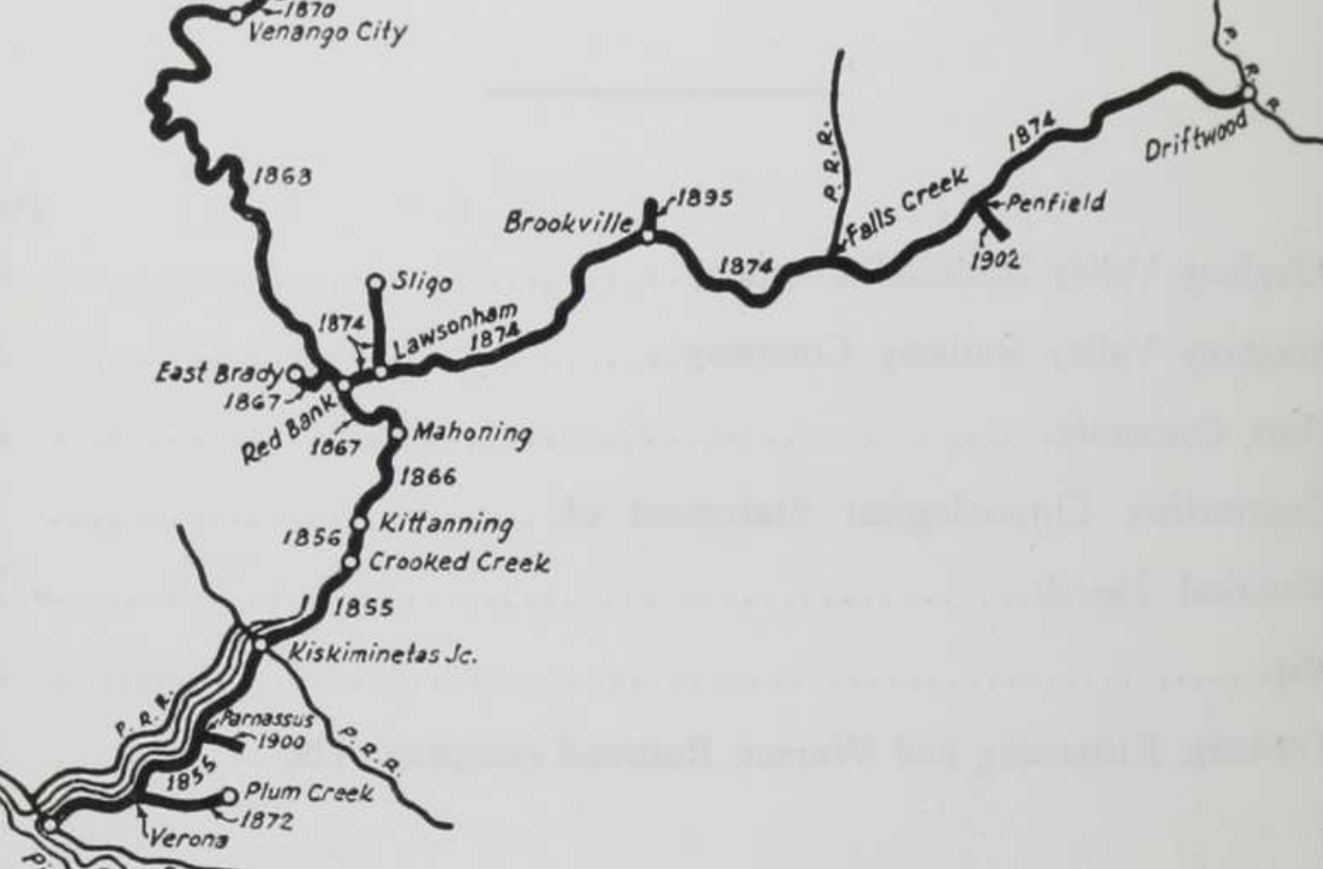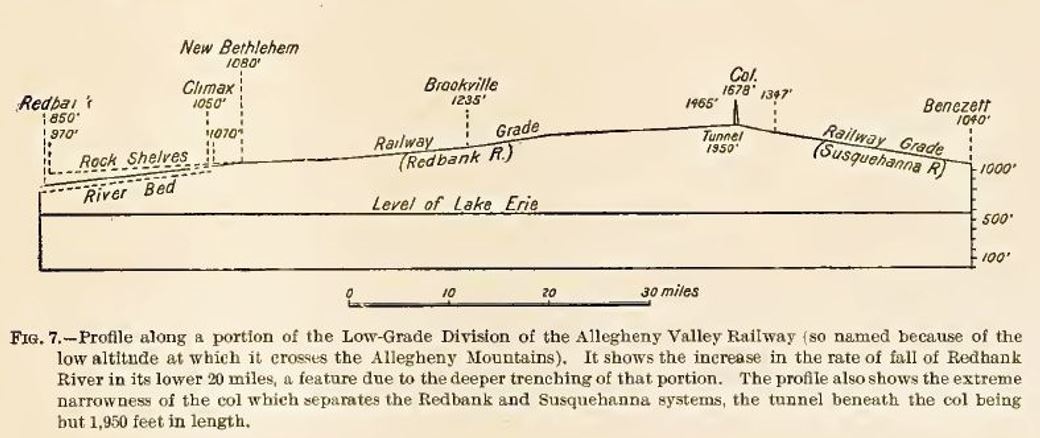The Allegheny Valley Railroad was one of many railroads that was eventually sucked into the giant corporation of the 19th century, the Pennsylvania Railroad (PRR). As the PRR approached its centennial, it published the definitive history of its own development. The material here is from that source, The Pennsylvania Railroad Company: The Corporate, Financial and Construction History of Lines Owned, Operated and Controlled to December 31, 1945, Volume 1 prepared by consulting engineers Coverdale & Copitts. (This link will take you to the Hagley Museum library and all 3 volumes of this massive work.)
Allegheny Valley Railway Company and the Allegheny Valley Railroad Company (pages 383-400)
The Allegheny Valley Railroad Company started construction in 1853 and completed the line from Pittsburgh to Kittanning, 44 miles, in January, 1856. The original name of the Company, when it was incorporated in 1837, was the Pittsburg, Kittanning and Warren Railroad Company but the terms of the incorporating act were not complied with and Letters Patent were not issued until 1852 in which year the name of the company was changed to Allegheny Valley Railroad Company. The Pittsburgh terminus was in the borough of Lawrenceville, now part of Pittsburgh, and a connection with the Pennsylvania Railroad was not made until 1862, at which time a connection was also made with the Pittsburgh, Fort Wayne and Chicago Railroad.
Financial difficulties prevented any further construction until 1863, and the extension from Kittanning to Mahoning, 10 miles, was not completed until April 1866. The discovery of oil near Titusville in 1859 made it desirable to extend the line to Oil City as soon as possible but it was not until January 1968 that Venango City was reached and the line to Oil City was not completed until February 1870.
A project to connect the Allegheny Valley with the Philadelphia and Erie, to provide a low grade line through to the east, had been contemplated for many years, and the Philadelphia and Erie started the construction of this road in 1868 but, as the Allegheny Valley Railroad Company had already been authorized to occupy this location, the construction work was assumed by this latter company and the Low Grade Division from Red Bank to Driftwood, 110 miles, was completed in 1874.
The Plum Creek Branch, 7.53 miles, was completed in 1872 and the Sligo Branch, 10.2 miles, in 1874. The cost of construction of the Low Grade Division and lack of sufficient earnings to pay the large interest charges finally resulted in bankruptcy and the railroad was operated by Receivers from May 2, 1884 until January 21, 1892, when the property was sold under court order and reorganized as Allegheny Valley Railway Company
At the time of reorganization, the railroad, including branches, was 259.4 miles in length, and very little change occurred in the mileage by 1910.
The Pennsylvania Railroad Company constructed its Brilliant Branch from the main line near East Liberty to a connection with the Allegheny Valley’s road near Coleman in 1903, and thereafter the railroad west of the junction was used for freight service only, the passenger trains running over the Brilliant Branch and the main line of the Pennsylvania Railroad into the Pittsburgh station.
The corporate property, rights and franchises were acquired by the Pennsylvania Railroad Company under an agreement filed in the office of the Secretary of the Commonwealth of Pennsylvania April 7, 1910.

CONSTRUCTION
The main line from Twelfth Street, Pittsburgh to Oil City follows closely the Allegheny River. The maximum effective grade is 0.49% against northward movement and 0.43% southward. The curvature is heavy, the maximum being 13 degrees 0 minutes in Pittsburgh. The maximum outside yard districts is generally less than 4 degrees 30 minutes.
There are now three tunnels on the River Division, one at East Brady 1462 feet long, one at Wood Hill 2733 feet long and one at Kennerdell 3512 feet long.
Red Bank to Driftwood, 109.96 miles
This portion of the road follows Red Bank Creek, Sandy Lick Creek and Bennetts Branch.
There are five tunnels on this portion of the road as follows:
Long Point - 646 feet long
Climax - 510 feet long
Brookville - 754 feet long
Sabula Summit - 1696 feet long
Caledonia - 424 feet long
The maximum effective grade is 0.30% against eastward movement and 0.70% westward. The maximum curvature is 9 degrees 21 minutes although generally the curvature is below 8 degrees. The gauge was 4’ 9” and the rail was originally 60 lbs per yard.
The longest bridge on this branch is one west of Driftwood which consists of 2 spans of through trusses carrying two tracks and having a total length of 323’ 10”. In addition to this bridge there are 16 plate girder bridges from 119’ to 301’ in length.
EQUIPMENT
As of December 31, 1909 the equipment owned by this company was as follows (Poors Manual):
Locomotives - 102
Passenger train cars - 67
Freight train cars - 3434
Cabin cars - 33
Service cars - 254
OPERATION
January 21, 1892 to March 1, 1892: by William H. Barnes, Receiver.
March 1, 1892 to August 1, 1900: by the company’s own organization.
August 1, 1900 to April 7, 1910: by the Pennsylvania Railroad Company, under lease dated July 14, 1900 for 20 years
ALLEGHENY VALLEY RAILROAD COMPANY
Incorporated under Special Acts of the Legislature of Pennsylvania of April 4, 1837 and April 14, 1852. Name was changed from the Pittsburg, Kittanning and Warren Railroad company under Special Act of 1852, above mentioned.
Effected under the name of the Pittsburg, Kittanning and Warren Railroad company. William F. Johnston was President and W. Milnor Roberts, Chief Engineer at the time of the name change.

CONSTRUCTION
Pittsburgh to Kittanning, 44 miles
Commenced March 17, 1853. Completed from Lawrenceville (Pittsburgh) to the Kiskiminetas River in October 1855, 29.00 miles; to Crooked Creek December 11, 1855, 13.00 miles, and to Kittanning January 23, 1856, 2.00 miles.
Kittanning to Mahoning, 10 miles
Commenced about July 1863. Completed about April 1866.
Mahoning to Venango City, 78.00 miles
Commenced about May 1866. Completed to Bradys Bend June 27, 1867 and to Venango City January 8, 1868.
Venango City to Oil City, 0.52 of a mile.
Completed February 2, 1870.
Red Bank to Driftwood, Pennsylvania, 110 miles
Commenced about June 1871. Completed May 4, 1874.
Plum Creek Branch, 7.53 miles
Completed about October 1872.
Sligo Branch, 10.20 miles
Constructed about 1874.
ADDITIONS AND BETTERMENTS
1874 – new engine house at Verona.
1875 – new machine shop, 112’ x 215’ with eight tracks entering the building from a transfer table at Verona.
Phillipsburg yard, consisting of 1.7 miles of tracks constructed to facilitate the making up of trains for the Low Grade Division.
1876 – the tunnel at Sabula Summit, 1696 feet long, was relined because of the failure of the original wood lining.
The engine house at Verona, containing 44 stalls, converted into a shop for repairing passenger and freight cars.
The tunnel at Caledonia, 424 feet long, relined.
1878 – combined passenger and freight station at Bennezette [sic]
1879 – new passenger station at Verona.
1880 – Howe-truss superstructure of two spans, having a total length of 678 feet, erected over the Allegheny River at Oil City.
New passenger station at Red Bank, to replace one destroyed by fire in 1879.
1881 – freight station, 85’ x 481’ at Sixteenth Street, Pittsburgh.
Brick engine house of 18 stalls at the foot of Forty-sixth Street, Pittsburgh.
Track along the river front from Seventeenth to Twentieth streets constructed to handle business to and from river boats and barges.
1882 – completed replacement of iron rail in the main tracks of the River Division with steel.
Brick engine house at Oil City erected to replace frame engine house destroyed by fire, March 30, 1882.
1883 – brass foundry fitted up at Verona shop.
1885 – brick passenger station 60.5’ x 21.5’ at Foxburg to replace the frame station destroyed by fire in 1884.
1888 – brick freight house 60’ x 25’ at Ford City.
1889 – new brick station 64’ x 20’ at Parnassus; a new combined freight and passenger station 71’ x 20’ at Mahoning, and a frame freight station at Reynoldsville.

